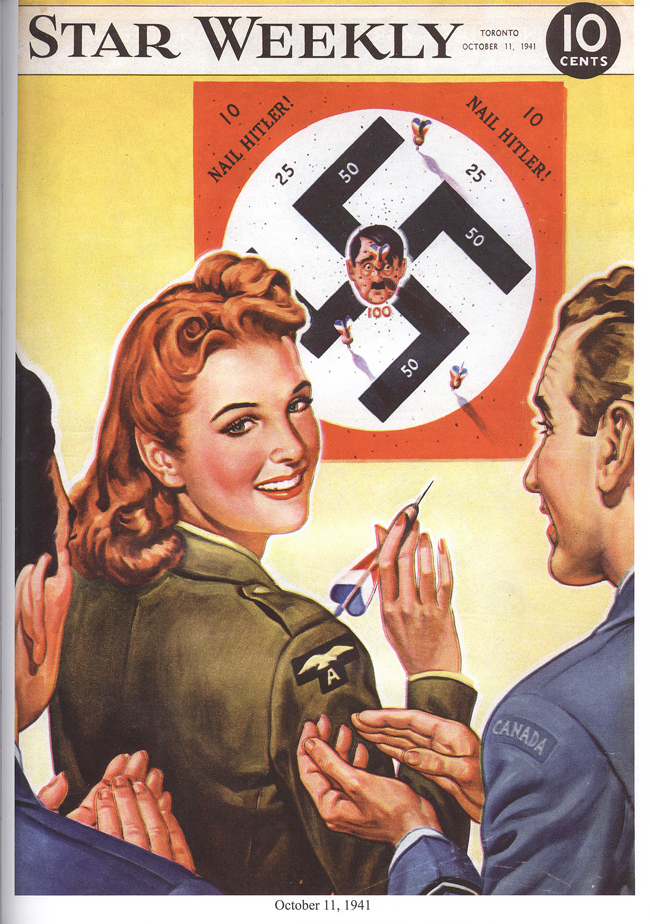As a child, I loved to pore through the colourful, patriotic and often amusing images pasted into my mother’s wartime scrapbook. Most of them were covers of the Star Weekly magazine, published by the Toronto Star.
(Note: To see ALL my covers, scroll to the bottom of the page).

The scrapbook created by my mother, June Light of Battleford, Saskatchewan, was a hard-sided ledger from the local land titles office, and it was just the right size for the oversized magazine covers, which measured sixteen by eleven inches. (Readers liked their magazines larger than life back then.) Unfortunately, it has suffered from decades of children’s scribbling and thumbing.

The Toronto Star published the Star Weekly magazine from 1910 to 1973. During the wartime years, from 1939 to 1945, the magazine featured many original coloured cover illustrations.
These illustrations tried to boost the country’s morale using sentiment and humour. After all, we were the good guys, fighting against the tyranny of an evil empire. And that is scarcely an exaggeration, although the Star Weekly reduced the Nazis to a pack of comical bunglers.
When I went looking online, I was delighted to find someone who collects Star Weekly magazines, Ian Macdonald of Ottawa. Not only that, but he created a book, using a combination of covers and inside pages from the magazine.

I phoned Mr. Macdonald in Ottawa to find out more about his collection. He told me that since more than fifty years has passed since the war ended, copyright has expired on these beautiful art works.
Incredibly, and I confirmed this with Robin Graham, Managing Director of Torstar Syndication Services, because I could hardly believe my ears when Mr. Macdonald told me, the Toronto Star itself never kept copies of its own magazine! What a shame.
Sadly, my mother rendered her covers worthless to collectors by trimming off all the mastheads. But at least they are full-sized images. Mr. Macdonald shrunk the covers to fit into his nine-by-eleven-inch book. Here is an original clipping in my mother’s scrapbook, and the copy in Mr. Macdonald’s glossy book.

Even without the mastheads, I still love these images. Many are pointedly Canadian, showing both our men and women in uniform. Canada’s role in wartime is often overlooked, so this collection is a small tribute to our country’s tremendous effort.
This image shows Vancouver’s Lion’s Gate bridge, being patrolled both by sea and by air. The caption reads: “With clock-like regularity, air and sea units of Canada’s Pacific patrol scour the ocean for enemy craft. Here Montague Black pictures a corvette and a Consolidated “Model 31” flying boat passing the great Lion’s Head bridge at Vancouver.”

Some covers feature wartime family life, like this sentimental depiction of a father and his little boy. During wartime, there was no way to protect children from the knowledge of war and its consequences.

* * * * *
My Star Weekly Cover Collection
Read about the inside pages of the magazine here: Inside the Star Weekly at War.
Read about one of the Star Weekly cover illustrators here: Elizabeth Cutler.
Read about another of the Star Weekly cover illustrators here: Emmett Watson.
And to see many other examples of these lovely cover images, simply scroll down the page . . .

















































































